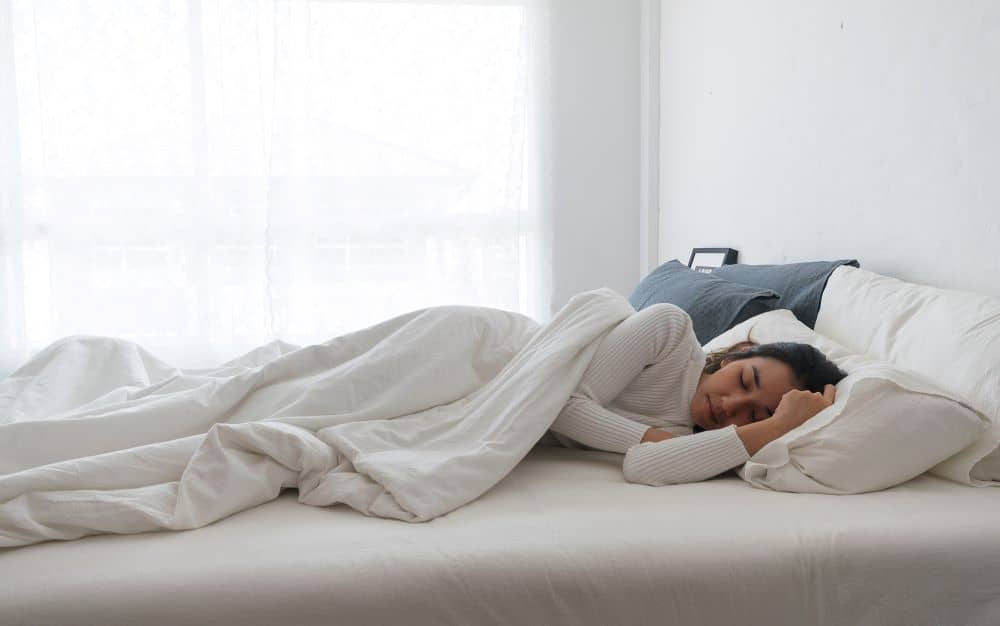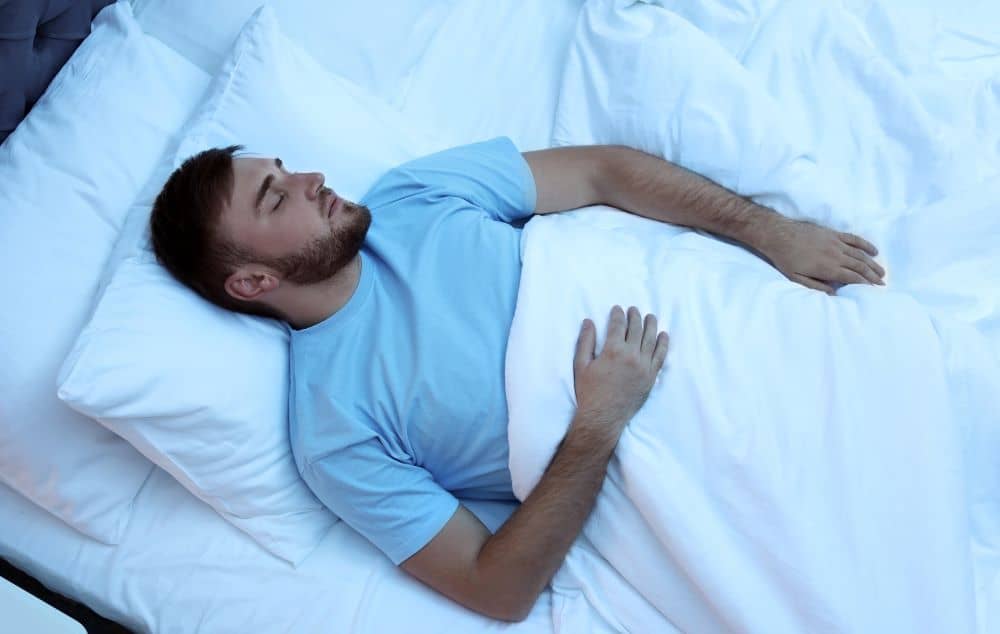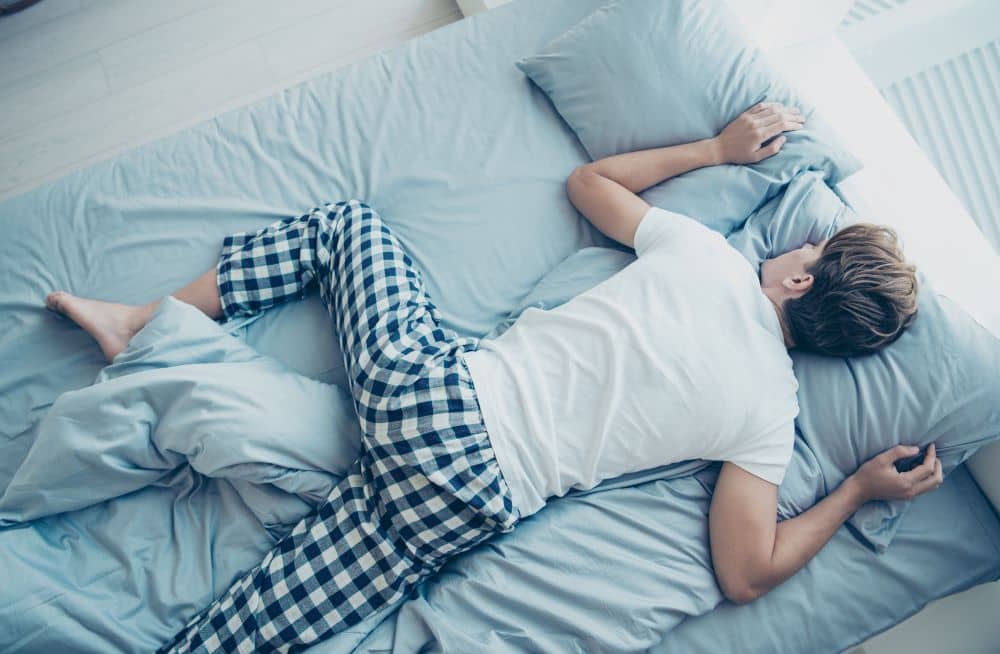Although opinions may vary, we believe nothing compares to coming home to a warm bed and falling into a deep sleep. While there is a myriad of experiences that cause us to grin with giddy anticipation — a fresh cup of coffee, leaving the office on Friday or crushing a gruelling workout — waking up feeling fresh and restored is in a league of its own.
But let’s cut to the chase: what are the best sleeping positions? Sure, we understand that sleeping in a chilled, dark location is ideal for optimal recovery, but what about the way we lie every night? For some sleepers, side sleeping with a pillow between their knees is an essential component of their nighttime routine. For others, this setup makes their skin crawl, and the idea of sleeping on their backs with their legs extended is much more attractive.
Whether you catch your z’s on your side, back, tummy or a hybrid modification of these orientations, here’s how to supercharge your slumber and feel like a million bucks tomorrow morning!
Side Sleeping
Side sleepers can jump and rejoice to know that their preferred orientation allows them to breathe efficiently during the deepest moments of rest, also known as rapid-eye-movement sleep (REM). Unlike their peers, side sleepers naturally position their airways in a manner that promotes optimal breathing, and it also prevents unwanted health ramifications that come as a result of having a constricted airway.
More importantly, side sleepers are less prone to developing sleep apnea in years to come. Sleep apnea, in its basic definition, is when an individual’s breathing patterns become disturbed during slumber. These sleepers report waking up feeling fatigued, foggy-brained, unwell and like they need to slip back under their covers even after getting 8 hours of recovery. These symptoms occur when sleep apnea forces the airway to shut down at night. In short, you stop breathing entirely, and the body becomes starved for oxygen and nutrients. This health issue, when left untreated, is deadly.
And for readers who struggle with indigestion and excessive heartburn, you’re in luck! Side sleeping promotes adequate digestion and movement of food through your body while you dream. Unlike other positions, side sleeping — specifically fetal position — helps reduce these side effects.
Back Sleeping
Back sleeping has long since been touted as the best way to sleep, but why has it earned this moniker? For starters, sleeping on your back is the best way to keep the integrity of your joints and bones in order as you age. If you’re waking up with aches, pains, creaky bones and agonizing discomfort in your lower back and hips, examine your sleep orientation.
And if you’re the type of individual who wants to look young and fresh with each passing year, back sleeping may be the solution. Unlike side and tummy positions, back sleeping allows your face to rest in its natural position. When your skin folds and contorts on your pillow, it leads to problematic skin issues like acne, fine lines, wrinkles, hyperpigmentation, dry skin, chapped lips and excessive redness.
Lastly, back positions allow our sinus cavities to drain while we snooze. Although this may sound gross or disgusting, passing mucus through your system is an essential component of maintaining your health and fighting trivialities like colds, fevers and sickness as a whole. For sleepers who regularly wake up with headaches, stuffiness and runny noses, sleeping on their back is life-changing!
Tummy Sleeping
We won’t lie: stomach sleeping gets a bad wrap. While it may be the least productive orientation that one can sleep in, it still provides numerous benefits when implemented correctly. Before discussing these advantages, we must first talk about what it means to sleep on your stomach “correctly.”
For starters, align your head, neck, spine and hips before slipping off into a dream. The most common detriment of tummy sleeping is how it wreaks havoc on your joints and causes pain and inflammation to appear out of nowhere.
After addressing this issue, consider switching your pillow out for a flat product. The flatter your pillow, the better your body can maintain its alignment while you doze off each night. Next, place a soft pillow under your pelvis to keep your spine in its natural position. While we envision our spinal column sitting in a straight line, its organic shape resembles an ‘s.’
Tummy sleeping is, without a doubt, one of the most comfortable orientations for most individuals. And when they take the necessary precautions, they can avoid unwanted respiratory issues, snoring and restlessness throughout the night.
Transitioning to a New Sleep Position
Changing your sleep position is a profoundly difficult task that many adults are afraid to try, and when they do, they become increasingly frustrated. While a tummy sleeper may understand how they’re selling themselves short with their lacklustre habit, transitioning to back or side sleeping is challenging at best.
To get started, be gentle with yourself! It’s essential to know that you won’t change your habit overnight. In the same way, it takes weeks and months to perform new routines and remove unproductive ones, sleeping in an unfamiliar way makes your brain go haywire. Pesky side effects like pins and needles, itchiness and restlessness are common, but don’t give up!
Instead, slowly increase the amount of time you spend in your new position each night. While sleeping on your back may only last a few minutes on night one, a month from now, you’ll sleep through an entire evening without noticing much discomfort. Like anything in life, baby steps are the essential component of permanent change and habit adaptation.
Which Position Is the Best?
Ultimately, the best sleeping position varies on the individual, and what works for one person may prove detrimental to your health. While some people can fall asleep in a matter of minutes on their back, some individuals will struggle for hours before catching a few hours of unproductive slumber.
However, readers will find the most benefits by sleeping on their backs, followed by sleeping on their sides in the fetal position. Results may vary, but here’s what we can realistically expect once we incorporate side and back sleeping into our nightly routines:
- Improved cardiovascular efficiency
- Better breathing
- Elevated mood and focus
- Fat loss
- Reduction of depression-like symptoms
- Joint and spine integrity
- An overall sense of well-being
The common denominator that all successful people share is their love for sleep. Not only sleep but high-quality sleep that leaves them feeling restored and motivated to engage with life’s beauty. Whether you’ve been suffering for years to catch a good night’s sleep or you’re a newcomer to the world of insomnia, back and side sleeping will revolutionize your nightly habits. Don’t take these facts lightly — sleep well tonight and start living your best life!



 Clicker ici pour un consultant Francphone.
Clicker ici pour un consultant Francphone.



